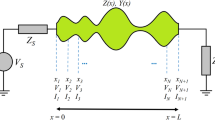Abstract
The variations in propagating characteristic of circular groove guide due to tolerance are analyzed by using eigen-weighted boundary integral equation method (EWBIEM). Theoretical analysis and experimental results show that as long as the tolerance of circular groove guide is not very large the variations in characteristic of circular groove guide are very small.
Similar content being viewed by others
References
Yang Hong-Sheng, Ma Jianglei and Lu Zhong-Zuo, "A New Type of Groove Guide", ISRAMT'89. pp239–240
Yang Hong-Sheng, Ma Jianglei and Lu Zhong-Zuo, "The Characteristic Equation and Solution of circular Groove Guide." International Journal of Infrared and Millimeter Waves, vol. 12 No. 5, May 1991, pp. 535–541
Wenxun Zhang, Engineering Electromagnetism: Functional Methods, Ellis Horwood Ltd. UK, 1991
Zhu, L., and Zhang, W.X, "The Eigen-Weighted BIEM for Solving Arbitrary Cross-section Waveguides" 1988 IEEE AP-S International Symposium, pp. 589–592
Jun Qian, Yang Hong-Sheng, Wenxun Zhang and Lu Zhong-Zuo, "Analytic Method of Arbitrary Cross Section Open Groove Guide", International Journal of Infrared and Millimeter Waves vol. 14, No. 2, Feb. 1993
Author information
Authors and Affiliations
Additional information
The Project Supported by National Natural Science Foundation of P.R. China
Rights and permissions
About this article
Cite this article
Hong-Sheng, Y., Qian, J. & Zhong-Zuo, L. The effect of tolerance on characteristic of circular groove guide. Int J Infrared Milli Waves 15, 1721–1731 (1994). https://doi.org/10.1007/BF02096899
Received:
Issue Date:
DOI: https://doi.org/10.1007/BF02096899



